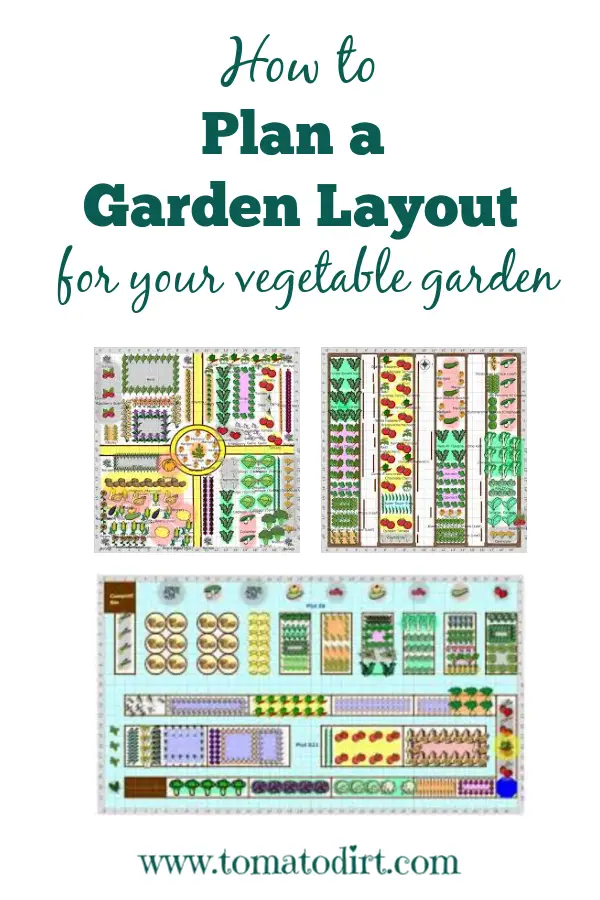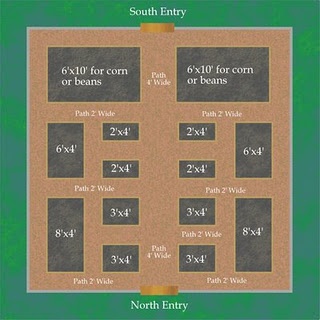FREE: 10 Must-Know Tomato Growing Tips Get The Guide
Read our affiliate disclosure here.
How to Plan a Garden Layout for Growing Vegetables and Tomatoes
Since 2010, Tomato Dirt has garnered 4.8+ million views, making it the web’s leading online source for growing tomatoes in the home garden. Award-winning writer and Tomato Dirt owner Kathy Widenhouse has helped thousands of home gardeners grow healthier tomatoes. Be one of them when you get Tomato Dirt’s Growing Guide here.
Updated 2.15.25
Planning your garden layout is a key to growing your own vegetables successfully. Careful thought now will maximize your garden’s productivity and save you extra work later on. Take these steps to make a layout for your garden, whether this is your first or fifty-first growing season.
Study your space
As you prepare to plan your layout, observe your growing area. Note the amount of sun and the movement of the light in your yard so you can make good decisions about where to start the garden.
Decide which vegetables to grow
Before you choose what crops to grow, consider their season. Which grow well in cool weather? Which must wait to be planted until the weather gets hot?
With careful planning, you can plant and harvest two or even three crops in the same part of the garden during one season in two or three successive waves, maximizing productivity. Common cool-season vegetables include beets, broccoli, cabbage, carrots, cauliflower, lettuce, peas, potatoes, radishes, spinach and turnips. Warm-season crops include beans, corn, cucumbers, eggplant, melons, peppers, pumpkins, squash and tomatoes.
Study their growing habits. Which vegetables grow best vertically, in single rows, or in blocks? Study seed envelopes and seedling packet labels. By planting a vertical crop like pole beans, interspersed with a creeping vine like pumpkins, you can maximize space.
Armed with this information, you’re ready to decide which vegetables you want to grow. With a little bit of planning you’ll be able to make informed decisions before drawing your layout. (Get more tips for choosing what vegetables to grow in your garden.)
Make a drawing
Determine the actual size of your garden space. Measure your plot carefully on all sides. Accurate measurements will allow you to plan how much room you have for plants.
Use a sheet of graph paper to plot your garden. Draw the garden plot according to scale. Label areas which get full sun, part shade, or full shade.
Sketch a layout
Using a pencil (so you can easily make changes), sketch rows, blocks and raised beds on the plot according to scale. Set up garden with tallest crops facing north, so they won’t shade shorter crops. Be sure to include space for the plants themselves and in between the plants and the rows. Let your layout sit for a day or two. Adjust the arrangement as you have new ideas.
Take notes
As you plant your garden and then throughout the season, make notes on your layout to remind yourself what worked well and what changes you want to try next year. Use a garden journal.
A garden layout is fluid. It can change not only season to season but also within a growing season itself. As you plan your first layout, make informed decisions and then give yourself some grace as you put your plan into effect. Your vegetables will, too!
More on Starting a Vegetable Garden
How To Start a Vegetable Garden Successfully: 10 Tips For Beginner Gardeners ...
18 Tips for Planning a Vegetable Garden (Even If It’s Winter) ...
7 Very Cheap Garden Fence Ideas ...
Spring Garden Clean Up: Get Your Garden Ready for the Season...
Use a garden journal to grow healthier crops and to grow as a gardener ...
3 Ways to Prepare Your Garden for Spring ...
Starting a vegetable garden: what you need to know ...
Starting a Raised Bed Vegetable Garden FAQs ...
3 types of planting in rows for your vegetable garden ...
Preparing Soil for Tomatoes: Frequently Asked Questions ...
How to pick the best home garden spot for growing tomatoes ...
Preparing your soil for planting tomatoes ...
See more Garden Layouts on our Pinterest board ...
Return from How to Plan a Garden Layout to Tomato Dirt home
As an Amazon Associate and Rakuten Advertising affiliate I earn from qualifying purchases.
SHARE THIS PAGE:
FREE! 10 Must-Know Tomato Growing Tips: 20-page guide
Get yours here:





